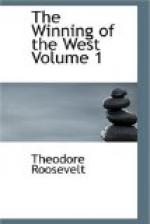had done him no wrong, and who thought that he was
friendly.[19] The other was Logan, an Iroquois warrior,
who lived at that time away from the bulk of his people,
but who was a man of note—in the loose
phraseology of the border, a chief or headman—among
the outlying parties of Senecas and Mingos, and the
fragments of broken tribes that dwelt along the upper
Ohio. He was a man of splendid appearance; over
six feet high, straight as a spear-shaft, with a countenance
as open as it was brave and manly,[20] until the wrongs
he endured stamped on it an expression of gloomy ferocity.
He had always been the friend of the white man, and
had been noted particularly for his kindness and gentleness
to children. Up to this time he had lived at
peace with the borderers, for though some of his kin
had been massacred by them years before, he had forgiven
the deed—perhaps not unmindful of the fact
that others of his kin had been concerned in still
more bloody massacres of the whites. A skilled
marksman and mighty hunter, of commanding dignity,
who treated all men with a grave courtesy that exacted
the same treatment in return, he was greatly liked
and respected by all the white hunters and frontiersmen
whose friendship and respect were worth having; they
admired him for his dexterity and prowess, and they
loved him for his straightforward honesty, and his
noble loyalty to his friends. One of these old
pioneer hunters has left on record[21] the statement
that he deemed “Logan the best specimen of humanity
he ever met with, either white or red.”
Such was Logan before the evil days came upon him.
Early in the spring the outlying settlers began again
to suffer from the deeds of straggling Indians.
Horses were stolen, one or two murders were committed,
the inhabitants of the more lonely cabins fled to the
forts, and the backwoodsmen began to threaten fierce
vengeance. On April 16th, three traders in the
employ of a man named Butler were attacked by some
of the outlaw Cherokees, one killed, another wounded,
and their goods plundered. Immediately after
this Conolly issued an open letter, commanding the
backwoodsmen to hold themselves in readiness to repel
any attack by the Indians, as the Shawnees were hostile.
Such a letter from Lord Dunmore’s lieutenant
amounted to a declaration of war, and there were sure
to be plenty of backwoodsmen who would put a very liberal
interpretation upon the order given them to repel an
attack. Its effects were seen instantly.
All the borderers prepared for war. Cresap was
near Wheeling at the time, with a band of hunters
and scouts, fearless men, who had adopted many of
the ways of the redskins, in addition to their method
of fighting. As soon as they received Conolly’s
letter they proceeded to declare war in the regular
Indian style, calling a council, planting the war-post,
and going through other savage ceremonies,[22] and
eagerly waited for a chance to attack their foes.




